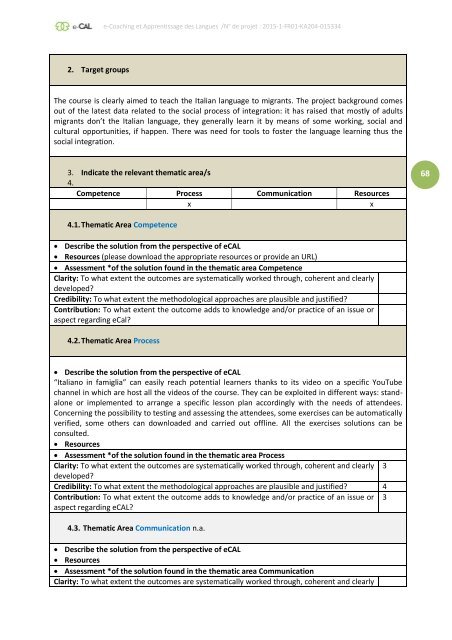e-CAL - e-Coaching et Apprentissage des Langues
The ERASMUS+ project e-CAL presents the result of an analysis of support methods in the case of language learning using web-based Open Educational Resources (OER).
The ERASMUS+ project e-CAL presents the result of an analysis of support methods in the case of language learning using web-based Open Educational Resources (OER).
You also want an ePaper? Increase the reach of your titles
YUMPU automatically turns print PDFs into web optimized ePapers that Google loves.
e-<strong>Coaching</strong> <strong>et</strong> <strong>Apprentissage</strong> <strong>des</strong> <strong>Langues</strong> /N° de proj<strong>et</strong> : 2015-1-FR01-KA204-015334<br />
2. Targ<strong>et</strong> groups<br />
The course is clearly aimed to teach the Italian language to migrants. The project background comes<br />
out of the latest data related to the social process of integration: it has raised that mostly of adults<br />
migrants don’t the Italian language, they generally learn it by means of some working, social and<br />
cultural opportunities, if happen. There was need for tools to foster the language learning thus the<br />
social integration.<br />
3. Indicate the relevant thematic area/s<br />
4.<br />
Comp<strong>et</strong>ence Process Communication Resources<br />
x<br />
x<br />
68<br />
4.1. Thematic Area Comp<strong>et</strong>ence<br />
Describe the solution from the perspective of e<strong>CAL</strong><br />
Resources (please download the appropriate resources or provide an URL)<br />
Assessment *of the solution found in the thematic area Comp<strong>et</strong>ence<br />
Clarity: To what extent the outcomes are systematically worked through, coherent and clearly<br />
developed?<br />
Credibility: To what extent the m<strong>et</strong>hodological approaches are plausible and justified?<br />
Contribution: To what extent the outcome adds to knowledge and/or practice of an issue or<br />
aspect regarding eCal?<br />
4.2. Thematic Area Process<br />
Describe the solution from the perspective of e<strong>CAL</strong><br />
“Italiano in famiglia” can easily reach potential learners thanks to its video on a specific YouTube<br />
channel in which are host all the videos of the course. They can be exploited in different ways: standalone<br />
or implemented to arrange a specific lesson plan accordingly with the needs of attendees.<br />
Concerning the possibility to testing and assessing the attendees, some exercises can be automatically<br />
verified, some others can downloaded and carried out offline. All the exercises solutions can be<br />
consulted.<br />
Resources<br />
Assessment *of the solution found in the thematic area Process<br />
Clarity: To what extent the outcomes are systematically worked through, coherent and clearly 3<br />
developed?<br />
Credibility: To what extent the m<strong>et</strong>hodological approaches are plausible and justified? 4<br />
Contribution: To what extent the outcome adds to knowledge and/or practice of an issue or 3<br />
aspect regarding e<strong>CAL</strong>?<br />
4.3. Thematic Area Communication n.a.<br />
Describe the solution from the perspective of e<strong>CAL</strong><br />
Resources<br />
Assessment *of the solution found in the thematic area Communication<br />
Clarity: To what extent the outcomes are systematically worked through, coherent and clearly


